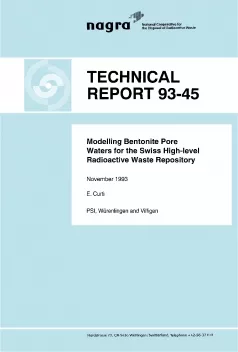
Technical Report NTB 93-45
Modelling Bentonite Pore Waters for the Swiss High-level Radioactive Waste Repository
The main objective of this investigation is to contribute to definition of representative compositions of bentonite pore waters in the near-field of the Swiss repository for high-level radioactive waste. Such compositions are necessary for determining the solubility limits of radionuclides for the safety analysis KRISTALLIN I.
To date, there is no generally accepted thermodynamic model which describes the dissolution behaviour of bentonite satisfactorily. Even the applicability of the concept of thermodynamic equilibrium to complex clay minerals (in this case montmorillonite) has been questioned. The model developed here is based on the premise, supported by experimental data, that the composition of bentonite pore waters is largely controlled by the dissolution or precipitation of reactive trace solids in bentonite. Although these solids occur in minor amounts (below 5 % volume), they may have a large effect on the pore water chemistry, by virtue of the very low water/rock ratios of the bentonite – water mixtures, and saturation may be easily reached.
Selectivity constants for the exchange equilibria among Na-K, Na-Ca, and Ca-Mg were derived from water – bentonite interaction experiments performed for Nagra by the British Geological Survey (BGS). These constants proved to be consistent with known literature values. In a second step, cross activity plots for dissolved chemical species were prepared with the help of speciation calculations. From these plots empirical solubility constants were extrapolated for a set of model solids which served, together with the exchange constants, to model the bentonite pore waters. The stoichiometries of the model solids were determined applying geochemical criteria. However, it could be demonstrated that many different sets of model solids lead to the same final results.
An important parameter for the prediction of radionuclide solubilities is the oxidation potential of the bentonite water. Since the BGS experiments yielded no information on this, the oxidation potential had to be estimated from model assumptions. It was postulated that it is controlled by equilibria among Fe2+ / Fe3+ solids occurring either in the bentonite itself or in other components of the repository. Specifically, it was assumed that the mineral magnetite – which should be the major corrosion product of steel – would be in excess, and that it would be in equilibrium either with goethite or with hematite occurring in the bentonite. Considering the large uncertainties of the thermodynamic data, these equilibria define a range of Eh values between -400 and +100 mV. Possible effects on the oxidation potential due to the release of ferric iron present in montmorillonite (which is the major iron reservoir in bentonite) were neglected because of lack of reliable equilibrium constants.
Bentonite pore waters were defined by computer simulation with the geochemical code MINEQL. The reaction between a sodium bentonite (MX-80) and reference waters for the crystalline basement of Northern Switzerland was evaluated applying the extrapolated selectivity and solubility constants. The ionic strength of the resulting bentonite pore waters was, in all cases, similar to that of the starting solutions. This feature can be easily explained by the absence of soluble anions (Cl-, SO42-) in the model solids. Calcite releases bicarbonate in significant amounts when it dissolves, but this has a limited effect on the ionic strength.
The bentonite pore waters have been modelled in a closed system, i.e. assuming that bentonite, once it has reacted with a fixed volume of groundwater, does not exchange further chemical species with an external reservoir. No attempt was made to model the evolution of the pore water by simulating diffusive exchange processes.
It can be anticipated that uncertainties in the concentrations of some major elements (e.g. AI, Si) will not significantly affect the calculated radionuclide solubilities. The latter will depend primarily on the concentrations of a few major ligands (OH-, Cl- and CO32-) and, for multivalent elements, also on the oxidation potential of the solution. As the bicarbonate and chloride concentrations can be predicted with a reasonable degree of confidence, it is recommended to focus future investigations on the assessment of pH-Eh conditions in the near-field pore waters.
